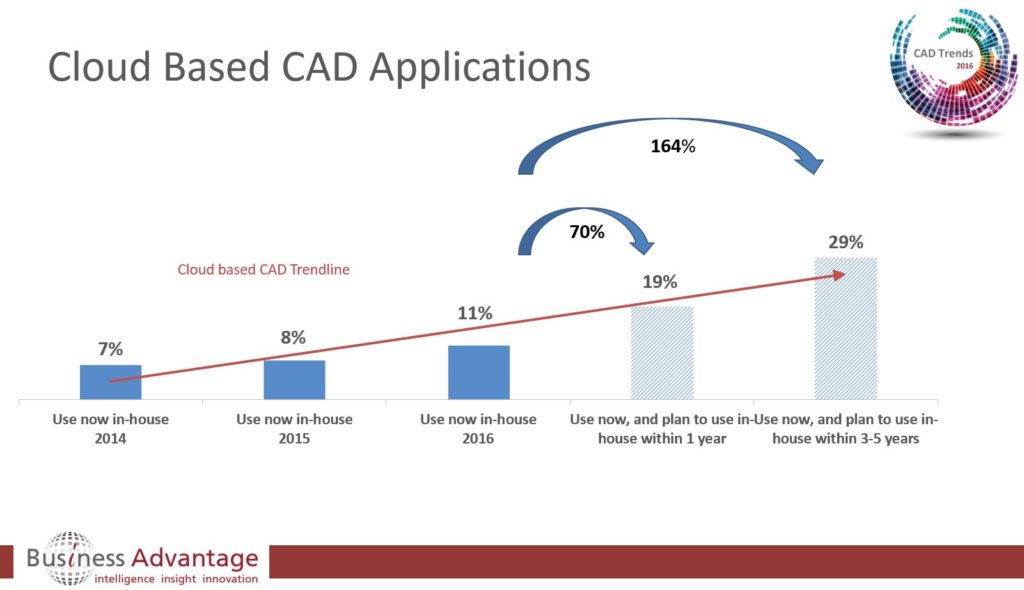The CAD sector has been making use of cloud storage services for many years now. These services have been used primarily for storage and file sharing, whilst the CAD software itself remains locally-stored on company servers.
Recent years, however, have seen a more general move towards cloud-based software, and CAD programs are no exception. More and more, software leaders have moved towards innovative fully cloud-based software. This means CAD is now available in-browser – no downloads required.

Current Impact
Several current leading CAD software companies have already launched cloud-based software, as noted in our recent news roundup.
 Onshape is the most notable developer of cloud-based CAD. They boast of being the first full-cloud 3D CAD application. This means no downloads and no updates – everything is in the cloud. You can even download the Onshape app, meaning you can now make edits on-the-go. It doesn’t matter where you are or which device you’re using – as long as you’re online, you can use Onshape.
Onshape is the most notable developer of cloud-based CAD. They boast of being the first full-cloud 3D CAD application. This means no downloads and no updates – everything is in the cloud. You can even download the Onshape app, meaning you can now make edits on-the-go. It doesn’t matter where you are or which device you’re using – as long as you’re online, you can use Onshape.

Long the big beast of desktop-based CAD software, Autodesk too is making a foray into cloud-based programs. We’ve previously covered the launch of AutoCAD 2017, and its embrace of the SaaS (Software as a Service) model. Now, there’s also Fusion 360. Unlike Onshape, this software does require a download. However, it is available across a range of devices, and is fully cloud-enabled, allowing you to edit and collaborate from anywhere. Thanks to the download, it’s also possible to make offline edits, giving you the best of both worlds.
Whilst these are two of the most notable cloud-based CAD programs, they’re far from the only ones out there. In fact, most CAD software developers are moving more and more towards the cloud.
For more interesting CAD trends, click here.
What Are The Pros And Cons?
Pros
-
- Accessibility… You can access your files anywhere, on any device. Teams can work simultaneously using real-time editing.
-
- Low Cost… You can pay for monthly subscriptions, which may be more cost-effective than an annual subscription.
-
- One License… You won’t have to buy multiple licenses for multiple devices – it’s available on any device via cloud.
-
- Continuous Improvement… Updates are automatic, so the application is constantly improving without any need for your input.
Cons
-
- Depends on The Internet… If your internet is unreliable, or suddenly goes down, you won’t be able to access any of your files.
-
- Security Issues… The cloud isn’t immune to security risks, which can be worrying if you’re dealing with confidential files.
-
- Provider Issues… If the provider wants to increase pricing, or goes out of business, you run the risk of losing your files.
-
- No Control… Updates and re-configurations are out of your control. You can’t revert back to older versions.
Despite the debate over the pros and cons of cloud-based CAD, it has already had a huge impact in the CAD industry, and will continue to do so in the future.
Trends and Impact
Business Advantage, a market research consultancy firm, anticipates a significant growth of 164% within the next 5 years for cloud-based CAD applications. This is found in their Worldwide CAD Trends 2016 survey.

Despite this projected growth, the survey found that the application has a below average importance ranking of 3.8 out of 10. In addition, its popularity is attributed predominantly to users in the AEC (Architecture, Engineering and Construction) sector. These users have a greater need for mobility, and thus rate it 4.5 out of 10.
Cloud-based CAD certainly has potential, particularly in the AEC sector. Onshape founder, Jon Hirschtick believes that it is the future of CAD. Yet even he notes that this application shouldn’t be your choice ‘if you have an unreliable internet connection’.
It’s this type of issue that makes the idea of a complete switch to cloud-based CAD applications seem uncertain, and further fuels resistance from some in the CAD industry.
So How Will The Cloud Impact on CAD?
It seems clear that despite its projected growth and growing popularity within the CAD industry, there’s still a lack of confidence for this type of application at the moment.
Old habits die hard, and many designers will prefer to continue using software they are most familiar with. Others may have issues with security, or the inability to make edits offline. So traditional CAD is far from dead.
This said, cloud-based CAD is growing. The possibilities are still becoming clear, and the technology is still evolving. Over the next few years, cloud-based CAD has the potential to have a huge impact on the design landscape.
No matter whether you’re using desktop-based or cloud-based software, Scan2CAD is still guaranteed to get you the best image results. Try out Scan2CAD’s full range of features completely free for 14 days with our free trial.

